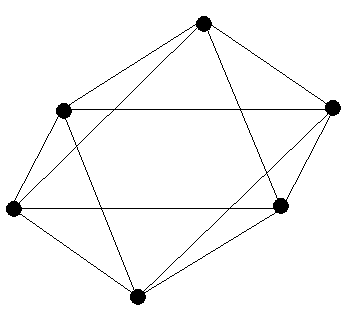
In the formation of octahedral complex ligands approach towards ___ and ___ orbital of central metal.
(A)
(B)
(C)
(D)
Answer
495.9k+ views
Hint: One needs to know the shapes of different d-orbitals in order to know which orbitals are approached at the time of formation of the octahedral complex. The shape of an octahedral complex is as below where black dots represent ligands.

Complete step by step answer:
- Generally, as we know ligands are negatively charged, neutral or in less occurrence cases positively charged as well. Regardless to all these changes, all ligands have high electron density.
- According to the Aufbau principle, Electrons are filled from lower to higher energy orbitals. For an octahedral case, this tends to be
Let us understand the basic concept of crystal field theory.
In simple words, it describes the breaking of orbital degeneracy in transition metal complexes due to the presence of ligands. This theory describes the strength of the metal ligand bonds, because the strength of the system is altered based on the metal ligand bond.
- Whenever ligands approach the central metal, they always tend to approach in such a way that the repulsion among them is the lowest. Generally a molecule with octahedral geometry approaches the metal ion along the x, y and z axes. Due to which the electrons in the
- For octahedral complexes, the crystal field splitting is denoted by
- The energies of the
- The energies of
Hence, in the formation of octahedral complex ligands approach towards
- So, option (A) is the required answer.
Note: Remember that ligands that cause a metal to have small crystal field splitting, which leads to high spin are called weak-field ligands and ligands that produce large crystal field splitting, which leads to low spin are called strong field ligands.

Complete step by step answer:
- Generally, as we know ligands are negatively charged, neutral or in less occurrence cases positively charged as well. Regardless to all these changes, all ligands have high electron density.
- According to the Aufbau principle, Electrons are filled from lower to higher energy orbitals. For an octahedral case, this tends to be
Let us understand the basic concept of crystal field theory.
In simple words, it describes the breaking of orbital degeneracy in transition metal complexes due to the presence of ligands. This theory describes the strength of the metal ligand bonds, because the strength of the system is altered based on the metal ligand bond.
- Whenever ligands approach the central metal, they always tend to approach in such a way that the repulsion among them is the lowest. Generally a molecule with octahedral geometry approaches the metal ion along the x, y and z axes. Due to which the electrons in the
- For octahedral complexes, the crystal field splitting is denoted by
- The energies of the
- The energies of
Hence, in the formation of octahedral complex ligands approach towards
- So, option (A) is the required answer.
Note: Remember that ligands that cause a metal to have small crystal field splitting, which leads to high spin are called weak-field ligands and ligands that produce large crystal field splitting, which leads to low spin are called strong field ligands.
Recently Updated Pages
Master Class 11 Economics: Engaging Questions & Answers for Success

Master Class 11 Business Studies: Engaging Questions & Answers for Success

Master Class 11 Accountancy: Engaging Questions & Answers for Success

Master Class 11 English: Engaging Questions & Answers for Success

Master Class 11 Computer Science: Engaging Questions & Answers for Success

Master Class 11 Maths: Engaging Questions & Answers for Success

Trending doubts
State and prove Bernoullis theorem class 11 physics CBSE

1 ton equals to A 100 kg B 1000 kg C 10 kg D 10000 class 11 physics CBSE

State the laws of reflection of light

One Metric ton is equal to kg A 10000 B 1000 C 100 class 11 physics CBSE

1 Quintal is equal to a 110 kg b 10 kg c 100kg d 1000 class 11 physics CBSE

Difference Between Prokaryotic Cells and Eukaryotic Cells




